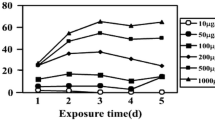Abstract
Foliar spraying ofArabidopsis thaliana (Columbia ecotype) plants with a 1.0-mM salicylic acid (SA) solution significantly improved their tolerance to subsequent paraquat (PQ)-induced oxidative damage. Leaf injuries, including losses of chlorophyll, protein, and fresh weight, were reduced. Our analysis of antioxidant enzymes in the leaves showed that SA pre-treatment effectively retarded rapid decreases in the activities of Superoxide dismutase (SOD), catalase, and ascorbate peroxidase that are normally associated with PQ exposure. In addition, guaiacol peroxidase activity was remarkably increased. In a native gel assay of peroxidase (POD) isozymes, staining activity of the POD1 isozyme, which disappeared in plants exposed only to 10 µM PQ, was significantly recovered by the 1.0-mM SA pre-treatment POD2 isozyme activity was also pronounced in all SA-treated plants compared with the control. A 12-h SA pre-treatment, without subsequent PQ stress, also caused a small increase in the endogenous H2O2 content that accompanies the symptoms of mild leaf injuries. This enhanced level occurred in parallel with a slight SOD increase and a catalase decrease. From our results, it can be assumed that, due to the small increase in SOD as well as catalase inactivation via SA pre-treatment, a moderate increase in H2O2 levels may occur. In turn, a large induction of guaiacol peroxidase leads to enhanced PQ tolerance inA. thaliana plants.
Similar content being viewed by others
Literature cited
Al-Hakimi AMA, Hamada AM (2001) Counteraction of salinity stress on wheat plants by grain soaking in ascorbic acid, thiamin or sodium salicylate. Biol Plant44: 253–261
Arnon Dl (1949) Copper enzymes in isolated chloroplasts. Polyphenoloxidase in Beta vulgaris. Plant Physiol24: 1–5
Asada K (1984) Chloroplasts: Formation of active oxygen and its scavenging. Methods Enzymol105: 422–429
Babbs CF, Pham JA, Coolbaugh RC (1989) Lethal hydroxyl radical production in paraquat-treated plants. Plant Physiol90: 1267–1270
Bernt E, Bergmeyer HU (1974) Inorganic peroxides, In HU Bergmeyer, ed, Methods of Enzymatic Analysis, Vol 4. Academic Press, 2246–2248
Chen Z, Silva H, Klessig DF (1993) Active oxygen species in the induction of plant systematic acquired resistance by salicylic acid. Science262: 1883
Dat JF, Lopez-Delgado H, Foyer CH, Scott IM (1998) Parallel changes in H2O2 and catalase during thermotolerance induced by salicylic acid or heat acclimation in mustard seedlings. Plant Physiol116: 1351–1357
Dhindsa RS, Plumb-Dhindsa F, Thorpe TA (1981) Leaf senescence: Correlated with increased levels of membrane permeability and lipid peroxidation, and decreased levels of superoxide dismutase and catalase. J Exp Bot52: 93–101
Fauth M, Merten A, Hahn MG, Jeblick W, Kauss H (1996) Competence for elicitation of hydrogen peroxide in hypocotyls of cucumber is induced by breaching the cuticle and is enhanced by salicylic acid. Plant Physiol110: 347–354
Foyer CH, Lopez-Delgado H, Dat JF, Scott IM (1997) Hydrogen peroxide- and glutathione-associated mechanisms of acclimatory stress tolerance and signalling. Physiol Plant100: 241–254
Giannopolitis CN, Ries SK (1977) Superoxide dismutases. 1. Occurrence in higher plants. Plant Physiol59: 309–314
Janda T, Szalai G, Pâldi E (1999) Hydroponic treatment with salicylic acid decreases the effects of chilling injury in maize (Zeamays L.) plants. Planta208: 175–180
Laemmli UK (1970) Cleavage of structural proteins during the assembly of the head of bacteriophage T4. Nature227: 680–685
Lopez-Delgado H, Dat J, Foyer CH, Scott IM (1998) Induction of thermotolerance in potato microplants by acetylsalicylic acid and H2O2. J Exp Bot49: 713–720
Lowry OH, Rosebrough NJ, Farr AL, Randall RJ (1951) Protein measurement with the folin phenol reagent. J Biol Chem193: 265–275
Martinez CA, Loureiro ME, Oliva MA, Maestri M (2001) Differential responses of Superoxide dismutase in freezing resistantSolarium curtilobum and freezing sensitiveSolarium curtilobum subjected to oxidative and water stress. Plant Sci160: 505–515
Pancheva TV, Popova LP, Uzunova AN (1996) Effects of salicylic acid on growth and photosynthesis in barley plants. J Plant Physiol149: 57–63
Polle A, Otter T, Scifert F (1994) Apoplastic peroxidases and lignification in needles of Norway spruce (Piceaabies L. Plant Physiol106: 53–60
Prasad TK, Anderson MD, Martin BA, Stewart CR (1994) Evidence for chilling-induced oxidative stress in maize seedlings and a regulatory role for hydrogen peroxide. Plant Cell6: 65–74
Rao MV, Davis RD (1999) Ozone-induced cell death occurs via two distinct mechanisms inArabidopsis: The role of salicylic acid. Plant J17: 603–614
Rao MV, Paliyath G, Ormrod DP (1996) Ultraviolet-B radiation and ozone-induced biochemical changes in the antioxidant enzymes of Arabidopsis thaliana. Plant Physiol110: 125–136
Rao MV, Paliyath G, Ormrod DP, Murr DP, Watkins CB (1997) Influence of salicylic acid on H2O2 production, oxidative stress, and H2O2-metabolizing enzymes. Plant Physiol115: 137–149
Raskin I (1992) Role of salicylic acid in plants. Annu Rev Plant Physiol Plant Mol Biol43: 439–463
Sharma YJ, Leon J, Raskin I, Davis KR (1996) Ozone-induced responses inArabidopsis thaliana: The role of salicylic acid in the accumulation of defense related transcripts and induced resistance. Proc Natl Acad Sci USA93: 5099–5104
Yalpani N, Enyedi AJ, Leon J, Raskin (1994) Ultraviolet light and ozone stimulate accumulation of salicylic acid, pathogenesis-related proteins and virus resistance in tobacco. Planta193: 372–376
Author information
Authors and Affiliations
Corresponding author
Rights and permissions
About this article
Cite this article
Kim, HS., Lim, CJ., Kim, JC. et al. Effects of salicylic acid on paraquat tolerance inArabidopsis thaliana plants. J. Plant Biol. 46, 31–37 (2003). https://doi.org/10.1007/BF03030298
Received:
Accepted:
Issue Date:
DOI: https://doi.org/10.1007/BF03030298




